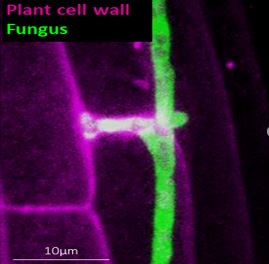A primary cell wall cellulose‐dependent defense mechanism against vascular pathogens revealed by time‐resolved dual‐transcriptomic
How do plants coordinate growth and defense against pathogens? A recent "BMC Biology" paper led by Alex Menna, Susanne Dora, and Gloria Sancho-Andrés from the Sánchez-Rodríguez group (IMPB) presents a novel molecular mechanism for how the dynamic regulation of cellulose synthesis during root vascular pathogens infection directly influences plant resistance to microbes.

Climate change is creating new niches for root vascular pathogens like the fungus Fusarium oxysporum fsp (Fo), with enormous agro‐economic and environmental impact. The pathogenicity of these microbes relies on their capacity to grow through the plant cell walls and reach and colonize the root vascular system. Their soil‐borne and resilient nature and their infection strategy based on root colonization make the chemical, cultural and biological controls generally ineffective to control them. To offer solutions to this global problem, a deeper molecular knowledge of the infection process is crucial.
Using the pathosystem Arabidopsis-Fo, researchers at IMPB showed dynamic transcriptional responses of both organisms at a high spatial and temporal resolution. These data, together with the evaluation of the response of different Arabidopsis mutants to vascular pathogens, allowed them to identify the vital role of cellulose during defense response to these microbes. They also found the signaling pathway governed by the phytohormone ethylene as a key molecular regulator of plant defense to vascular pathogens and the main molecular basis for resistance associated with cellulose‐deficiency during Fo infection.
The study identifies an essential mechanism for growth adaptation in response to biotic stress and its influence on defense. These findings represent an essential resource for the generation of plant resistance to Fo that can be transferred to other vascular pathosystems.
Link to the paper in external page BMC Biolology